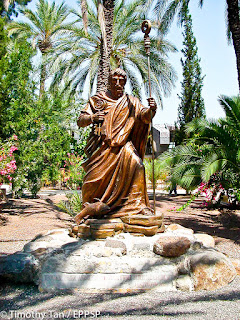Bucket List: Journey to Biblical Tiberias and Galilee
Tiberias and Galille, Israel
Growing up in a Catholic family, I had been schooled and taught the bible since young. Thus, while the lands of Tiberias and Galilee were foreign to me, the names definitely were familiar ones. Having an inquisitive mind and a streak of wanderlust in me since my childhood days, I had told myself I shall visit these regions when I am a grown up. This bucket list travel item was fulfilled in 2002 when I visited the region for the first time as part of a packaged tour group.
The Tiberias of today is a city on the western shores of the Sea of Galilee with a population of about 45,000. The region and the Sea of Galilee were mentioned many times in the Bible. The Sea of Galilee was where Jesus walked on the water and the surrounding regions were where Jesus spent much time with his disciples.
Sea of Galilee with the view of the Golan Heights in the background, Tiberias, Galilee, Israel (2002)
It should be noted that the Sea of Galilee is actually a freshwater lake. At about 210 metres below sea level, the Sea of Galilee is the second lowest-lake on earth after the Dead Sea. In some literature, it is also known as Lake Tiberias. Because of its historical biblical links, the region is a major tourists
destination. For Christians, it is also considered a destination of pilgrimage interest.
During my first visit to the region, I did what most tourists do and visited most of the sites of historical and biblical interests. And if visiting historical churches and praying at the altars of these churches could be considered a pilgrimage thing, then I was probably also a pilgrim during that visit.
My activities as a tourist include paying homage (sort of) to a statue of St Peter as well as visiting and taking lots of photographs of the Sea of Galilee and its surrounding sights. My only "pilgrimage" duty was basically just praying at the Church of the Multiplication of Loaves and Fishes. The Church is located slightly north-east on the shores of the Sea of Galilee. The current structure of the church was built on the same site as two earlier churches. One of the main features of the church was its mosaics, some dating as far back as the 5th century. In front of the altar, is a mosaic depicting two fishes flanking a basket with four loaves of bread, a highly-probable reference to the Miracle of the "Feeding of the Multitudes" as recorded in all four synoptic gospels (the gospels of Matthew, Mark, Luke and John). Standing before the altar and praying in a church with such rich historical links to events depicted in the Bible was a surreal experience for me.
Mosaic depicting two fishes flanking a basket with four loaves of bread, Church of the Multiplication of Loaves and Fishes, Tabgha, Galilee, Israel (2002)
After my touristy and pilgrimage duties were completed, I settled down for lunch. And of course, I had to dine on the famous St Peter's Fish! From the Gospel of Matthew, it was written that Peter had went fishing in the lake on the instruction of Jesus because the first fish he caught would have a silver shekel (coin) in it. Peter could then use this silver shekel to pay the Temple tax.
For those who do not know, St Peter's Fish is actually a tilapia, a fresh water fish of the Cichlid family.
And that was my first trip to the biblical lands of Tiberias and Galilee. No longer so foreign to me after my first visit, I checked off my travel bucket list item. A childhood dream fulfilled. Although I did return to the region in subsequent years, it was always the first trip that made the most impression.
Pleasure watercraft on the western shores of the Sea of Galilee, Tiberias, Galilee, Israel (2002)








Comments
Post a Comment